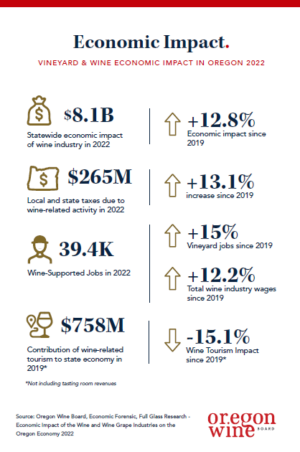With an $8 billion economic impact, Oregon’s vineyards and wine businesses continue to be an economic driver deeply rooted in the state’s agriculture, offering high-value tourism experiences despite fewer tasting room visits.
 PORTLAND, OR, March 27, 2024 — The economic contributions grape growing and wine industries make to Oregon grew almost $1 billion from 2019 to 2022, according to the new report released today by the Oregon Wine Board. Conducted by Dr. Robert Eyler of Economic Forensics and Analytics, Inc. and Christian Miller, proprietor of Full Glass Research, the Economic Impact Report is published every three years. The report provides a snapshot of every grape and wine industry tier that contributed to the overall economy. The wide breadth and depth of data present a complete and accurate estimate of Oregon’s wine industry’s economic impact. However, the report is based on 2022 data and can be supplemented with more recent (2023) studies on wine industry sales.
PORTLAND, OR, March 27, 2024 — The economic contributions grape growing and wine industries make to Oregon grew almost $1 billion from 2019 to 2022, according to the new report released today by the Oregon Wine Board. Conducted by Dr. Robert Eyler of Economic Forensics and Analytics, Inc. and Christian Miller, proprietor of Full Glass Research, the Economic Impact Report is published every three years. The report provides a snapshot of every grape and wine industry tier that contributed to the overall economy. The wide breadth and depth of data present a complete and accurate estimate of Oregon’s wine industry’s economic impact. However, the report is based on 2022 data and can be supplemented with more recent (2023) studies on wine industry sales.
The sum of all economic activity resulting from grape growing, wine production, sales, and promotion in Oregon was $8.1 billion in 2022, compared to $7.2 billion three years prior, a 12.8% increase in statewide impact. This data shows compelling evidence that wine is an economic driver for the state, with financial implications in agriculture – from winery and grower revenues to wholesale and retail sales of Oregon wine.
Other economic considerations include related industries such as trucking and professional services, wages throughout the supply chain, and the effect of employees spending those wages in Oregon. Some of this growth was also attributed to inflation.
Additionally, planted acreage grew by 19.5% compared to 2021, as domestic and global demand for Oregon wines increased, with total sales jumping 9%. Oregon wine grapes remain the state’s most valuable fruit crop, with a total market value of $330 million, including grapes harvested at estate wineries.
“Oregon’s wine industry continues to create more income for businesses, households, and government through a mix of core and allied industries,” said Gina Bianco, Executive Director of the Oregon Wine Board. “Due to the quality, desirability, and price point of Oregon wines, we continue to be more resilient and outperform other wine regions in major retail store channels.”
Wine-supported job wages soared 12.2%, due to both inflation and a shift to a more skilled workforce. At the same time, overall employment supported by the wine industry was down 1.5%. The total number of jobs supported by Oregon’s wine industry was just under 40K and remained stable. The category that grew the largest was vineyard stewards, which increased by 15%, aligning with the upward trend in planted acreage.
Also, fewer visitors went to Oregon’s tasting rooms in 2022. The authors write, “the pandemic’s shadow remains on Oregon’s economy and wine industry, though it is fading.” Using Community Benchmark data, researchers concluded that the average number of visitors per winery was down 36% from 2019. Wine-supported tourism accounted for $758 million in statewide revenues through lodging, dining, and other activities (not including sales from tasting rooms counted in the winery revenue section). Overall, wine tourism saw a 15.1% decrease from 2019 spending of $893 million.
Eyler notes in the report, “Sales increased as wholesalers replenished inventories, but in 2022, wine sales in all tiers, from wineries to retail, began to decline. Two major forces are at work: (1) pandemic impacts on trade and consumer behavior; (2) shifts in consumer preferences related to wine. Oregon wines were more resilient than those from many other regions because their production is concentrated in the more in-demand price segments and varieties, and many were able to adapt to channel shifting by boosting club and online sales and expanding direct-to-trade and local consumer sales”.
The consumers who did make it to tasting rooms bought more premium-priced wines, resulting in higher expenditures per winery visitor. In the report, Miller referred to this as a “trading up” phenomenon, in which fewer visitors were buying fewer bottles but choosing more expensive ones, with 72% of visitors to tasting rooms making purchases.
The table below illustrates this phenomenon by showing an increase in tasting room revenues despite a decrease in case sales volume between 2019 and 2022.
|
Measure |
2019 |
2022 |
|
Total TR revenues |
173,009,188 |
247,848,160 |
|
Total TR cases sold |
532,807 |
497,393 |
With state and local taxes at $265 million, property value increase caused a rise in taxes revenues of 13.1%.
At the 2024 Oregon Wine Symposium, Eyler pointed to forces that continue to affect the wine industry, including public policy trends, high interest rates, and resilience wearing thin as the industry navigated headwinds over the past few years. Inflation’s impact on U.S. households has continued to affect retail sales, as those who once stocked up on wine six times a year are now buying less volume and with less frequency.
About the Oregon Wine Board
The Oregon Wine Board is a semi-independent Oregon state agency managing marketing, research, and education initiatives that support and advance the Oregon wine and wine grape industry. The Board works on behalf of all Oregon wineries and independent growers throughout the state’s diverse winegrowing regions. To learn more, visit industry.oregonwine.org




